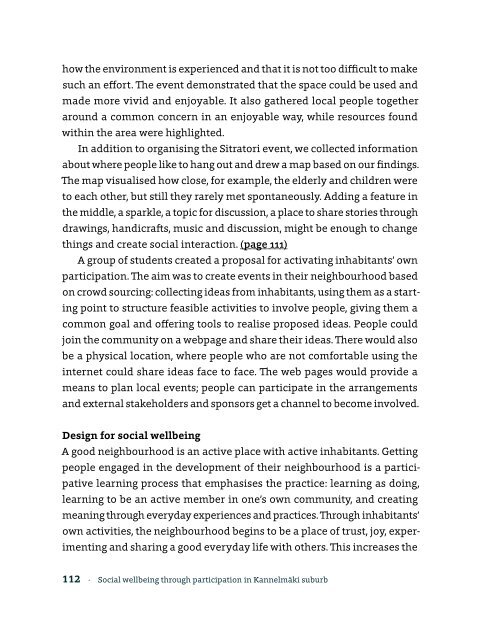Designing for wellbeing
Designing for wellbeing
Designing for wellbeing
Create successful ePaper yourself
Turn your PDF publications into a flip-book with our unique Google optimized e-Paper software.
how the environment is experienced and that it is not too difficult to make<br />
such an ef<strong>for</strong>t. The event demonstrated that the space could be used and<br />
made more vivid and enjoyable. It also gathered local people together<br />
around a common concern in an enjoyable way, while resources found<br />
within the area were highlighted.<br />
In addition to organising the Sitratori event, we collected in<strong>for</strong>mation<br />
about where people like to hang out and drew a map based on our findings.<br />
The map visualised how close, <strong>for</strong> example, the elderly and children were<br />
to each other, but still they rarely met spontaneously. Adding a feature in<br />
the middle, a sparkle, a topic <strong>for</strong> discussion, a place to share stories through<br />
drawings, handicrafts, music and discussion, might be enough to change<br />
things and create social interaction. (page 111)<br />
A group of students created a proposal <strong>for</strong> activating inhabitants’ own<br />
participation. The aim was to create events in their neighbourhood based<br />
on crowd sourcing: collecting ideas from inhabitants, using them as a starting<br />
point to structure feasible activities to involve people, giving them a<br />
common goal and offering tools to realise proposed ideas. People could<br />
join the community on a webpage and share their ideas. There would also<br />
be a physical location, where people who are not com<strong>for</strong>table using the<br />
internet could share ideas face to face. The web pages would provide a<br />
means to plan local events; people can participate in the arrangements<br />
and external stakeholders and sponsors get a channel to become involved.<br />
Design <strong>for</strong> social <strong>wellbeing</strong><br />
A good neighbourhood is an active place with active inhabitants. Getting<br />
people engaged in the development of their neighbourhood is a participative<br />
learning process that emphasises the practice: learning as doing,<br />
learning to be an active member in one’s own community, and creating<br />
meaning through everyday experiences and practices. Through inhabitants’<br />
own activities, the neighbourhood begins to be a place of trust, joy, experimenting<br />
and sharing a good everyday life with others. This increases the<br />
112 · Social <strong>wellbeing</strong> through participation in Kannelmäki suburb
















